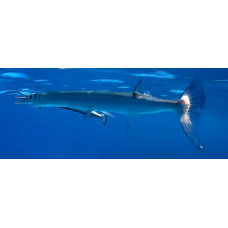Latin name
Tylosurus crocodilus
Other names
Сrocodile needlefish
Identification
The main difference between this fish and other members of the genus Tylosurus is that the teeth of juveniles are pointed forward. The teeth of other species are straight at all ages. The houndfish also has a more cylindrical body and a shorter head. The fish has a distinct keel on the caudal process, and the caudal fin itself is strongly bifurcated. The houndfish has 80-86 vertebrae.
Features of fish fins
The Houndfish has no spines, its dorsal fin has 21-25 soft rays and the anal fin has 19-22.
Fish colouring
Adult fish have a dark blue back with silver-white sides and a white belly. Juveniles have a raised black blade on the back of the dorsal fin.
Distribution
In the Indian and Pacific Oceans, this fish is found in the Red Sea and from the coast of South Africa, east to French Polynesia, north to Japan, and south to New South Wales, Australia. In the western Atlantic it is known from New Jersey to Brazil, and in the east they are found from Fernando Pou, Cameroon and Liberia to Ascension Island. Houndfish can also be found near Guinea, Senegal and Cape Verde. It has been recorded in the eastern Mediterranean, having migrated from the Red Sea through the Suez Canal.
Habitat
Marine oceanodromous tropical species. The depth range is from 0 to 13 meters. Being a pelagic animal, the houndfish can be found in lagoons and coastal reefs.
Size
The longest recorded fish was 150 centimeters (4.9 feet) and the largest recorded weight was 6.35 kilograms (14.0 pounds).
Behavior
Houndfish usually swim alone or in small groups.
Food and feeding habits
It feeds mainly on small fish.
Reproduction
Lays eggs that attach to objects in the water, have tendrils on the surface of each egg.
Fishing
The Houndfish is considered dangerous and is feared by fishermen because of its size and tendency to leap out of the water and inflict puncture wounds with its beak when startled or attracted by the light used to catch it.
Relationship with a person
It is considered an edible fish and is usually sold fresh, but there is little demand for it because its flesh has a greenish color.
| Classification | |
| Phylum | Chordata |
| Class | Actinopterygii |
| Squad | Beloniformes |
| Family | Belonidae |
| Genus | Tylosurus |
| Species | T. crocodilus |
| Features | |
| Conservation status | Least Concern |
| Habitat | Pelagic |
| Life span, years | No information |
| Maximum body weight, kg | 6,35 |
| Maximum length, cm | 150 |
| Sailing speed, m/s | No information |
| Threat to people | Edible |
| Way of eating | Predator |
Houndfish
Tags: houndfish



